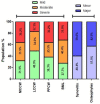Autologous Micro-Fragmented Adipose Tissue (MFAT) to Treat Symptomatic Knee Osteoarthritis: Early Outcomes of a Consecutive Case Series
- PMID: 34064010
- PMCID: PMC8196751
- DOI: 10.3390/jcm10112231
Autologous Micro-Fragmented Adipose Tissue (MFAT) to Treat Symptomatic Knee Osteoarthritis: Early Outcomes of a Consecutive Case Series
Abstract
The study aimed to evaluate the short-term clinical effect, therapeutic response rate (TRR%), and therapy safety of a single intra-articular autologous MFAT injection for symptomatic knee OA. Secondly, patient- and pathology-related parameters were investigated to tighten patient selection for MFAT therapy. Sixty-four subjects with symptomatic mild-severe knee OA were enrolled in a single-center trial and received a unilateral (n = 37) or bilateral (n = 27) MFAT injection. After liposuction, the adipose tissue was mechanically processed with the Lipogem® device, which eventually produced 8-10 cc of MFAT. Subjects were clinically assessed by means of the KOOS, NRS, UCLA, and EQ-5D at baseline and 1, 3, 6, and 12 months after injection. Adverse events were recorded at each follow-up timepoint. The TRR was defined according to the OMERACT-OARSI criteria and baseline MRI was scored following the MOAKS classification. The TRR of the index knee was 64% at 3 months and 45% at 12 months after injection. Therapy responders at 12 months improved with 28.3 ± 11.4 on KOOS pain, while non-responders lost -2.1 ± 11.2 points. All clinical scores, except the UCLA, improved significantly at follow-up compared to baseline (p < 0.05). In the bilateral cohort, no difference in baseline scores or TRR was found between the index knee and contralateral knee (n.s.). An inflammatory reaction was reported in 79% of knees and resolved spontaneously within 16.6 ± 13.5 days after MFAT administration. Numerous bone marrow lesions (BML) were negatively correlated with the TRR at 12 months (p = 0.003). The study demonstrated an early clinical improvement but a mediocre response rate of 45% at 12 months after a single intra-articular injection with autologous MFAT. Assessment of bone marrow lesions on MRI can be helpful to increase the therapeutic responsiveness of MFAT up to 70% at 12 months. In comparison to repetitive injection therapies such as cortisone, hyaluronic acid, and PRP, administration of MFAT might become a relevant alternative in well-selected patients with symptomatic knee OA.
Keywords: adipose tissue; autologous; biological; knee; osteoarthritis.
Conflict of interest statement
One of the authors is a paid consultant for Lipogems® (Lipogems International SpA, Milan, Italy).
Figures






References
-
- Deshpande B.R., Katz J.N., Solomon D.H., Yelin E.H., Hunter D.J., Messier S.P., Suter L.G., Losina E. The number of persons with symptomatic knee osteoarthritis in the United States: Impact of race/ethnicity, age, sex, and obesity. Arthritis Care Res. 2016;68:1743–1750. doi: 10.1002/acr.22897. - DOI - PMC - PubMed
-
- Evans J.T., Walker R.W., Evans J.P., Blom A.W., Sayers A., Whitehouse M.R. How long does a knee replacement last? A systematic review and meta-analysis of case series and national registry reports with more than 15 years of follow-up. Lancet. 2019;393:655–663. doi: 10.1016/S0140-6736(18)32531-5. - DOI - PMC - PubMed
LinkOut - more resources
Full Text Sources
Research Materials
Miscellaneous

